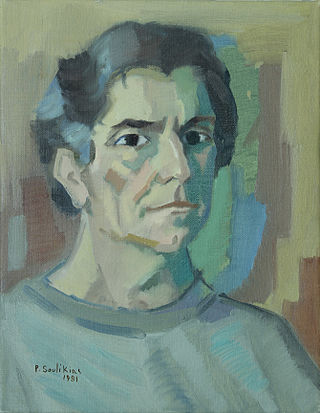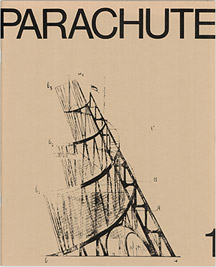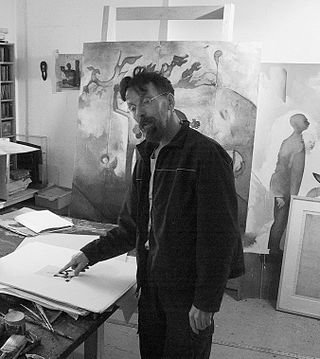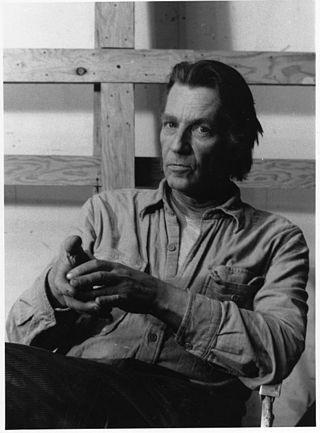
Betty Roodish Goodwin, was a multidisciplinary Canadian artist who expressed the complexity of human experience through her work.
Roy Arden is an artist who is a member of the Vancouver School. He creates sculpture from found objects, oil paintings, graphite drawings and collage, and curates and writes on contemporary art.
Henry Saxe is a Canadian artist who creates sculpture, painting and drawing.
Alain Paiement is a Canadian artist. His work is mainly made from photography in form of installations, sculptures, and photomontage. His themes are related to geography, topography and architecture and mainly concerned by the construction of vision. A photo of the French artist Pierre Estable's apartment titled "Living Chaos" has been exhibited at the Galerie Clark from May 10 to June 17, 2001.

Paleologos Soulikias was a Greek-Canadian artist painter, known primarily for his Canadian landscape scenes.
Ron Terada is a Vancouver-based artist working in various media, including painting, photography, video, sound, books, and graphic design.

France Jodoin is a Canadian contemporary artist known for her maritime scenes. Painted in a semi-abstract style, her work is a modern interpretation of European Romanticism. Her work is found in Quebec museums, and in galleries in Canada, France and the United States.
Lorna Brown is a Canadian artist, curator and writer. Her work focuses on public space, social phenomena such as boredom, and institutional structures and systems.
Carol Wainio is a Canadian painter. Her work, known for its visual complexity and monochrome color palette, has been exhibited in major art galleries in Canada, the U.S., Europe and China. She has won multiple awards, including the Governor General's Award in Visual and Media Arts.
Peter Krausz is a Romanian-born Canadian artist. Throughout his career, he worked within the fields of painting, drawing, installation, and photography and, since 1970, exhibited in museums and galleries across Canada, the United States, and Europe. He is best known for large-scale landscape paintings of the Mediterranean.

Kevin Sonmor (1959) is a Canadian artist known for paintings of still lifes, equine and marine scenes. A postmodernist, Sonmor blurs the boundaries between contemporary abstract landscape and historic landscape traditions by creating a visual language which is both representational and symbolic. His work is exhibited in public and private galleries across North America and in Europe.

Parachute - revue d'art contemporain was a bilingual French and English contemporary art magazine. It was published quarterly in October, January and April. One issue each year was dedicated to an emerging metropolis for contemporary art. Parachute was concerned primarily with the visual arts and museology. The magazine occasionally devoted articles to other art forms when they transcended their conventional boundaries and provoked theoretical debates. The last issue, No. 125, appeared in 2009 when decreasing funding levels made it impossible to continue operation.

Louis-Pierre Bougie was a Canadian painter and printmaker specialized in engraving and etching. He developed his knowledge of intaglio techniques at Atelier Lacourière-Frélaut in Paris, where he worked for fifteen years, and through travel and study in France, Portugal, Poland, Ireland, Finland, and New York. His work is regularly shown in Canadian, American, and European galleries, and is represented in major public and private collections, notably in Québec and New York. Bougie was considered Québec's foremost engraver for the depth and consistency of his work. He died from pneumonia.
Renée Van Halm is a Canadian contemporary visual artist born in Haarlemmermeer, the Netherlands (1949) and immigrated to Canada in 1953.
Kathy Slade (1966) is a Canadian artist, author, curator, editor, and publisher born in Montreal, Quebec, and based in Vancouver, British Columbia. She is currently a Term Lecturer at Simon Fraser University's School for the Contemporary Arts.
Angela Grauerholz D.F.A. is a German-born Canadian photographer, graphic designer and educator living in Montreal.
Dominique Blain is a Canadian artist living and working in Montreal, Quebec. Her work incorporates photography, installation and sculpture. She explores political themes in her art such as war, racism and slavery. Her body of work speaks to universal topics close to human fate.
Barbara Steinman D.F.A. is a Canadian artist known for her work in video and installation art.
Karen Tam is a Canadian artist and curator who focuses on the constructions and imaginations of cultures and communities through installations in which she recreates Chinese restaurants, karaoke lounges, opium dens, curio shops and other sites of cultural encounters. She is based in Montreal, Quebec.

Edmund Alleyn had an art career that underwent many stylistic changes. He explored various styles of painting including abstraction, narrative figuration, technology and pop art, as well as different media. Critics feel that his inability to be categorized marks him as contemporary. Even more important, they say that he helped remove excessive compartmentalization from art practice.







